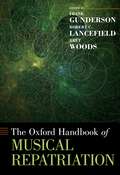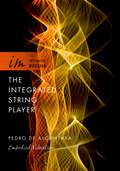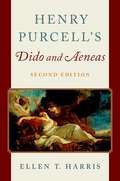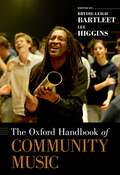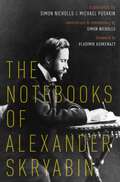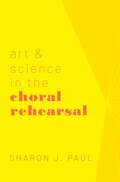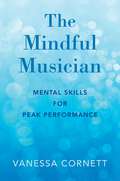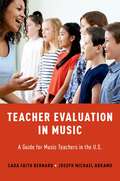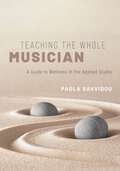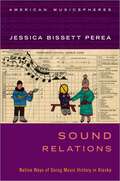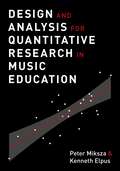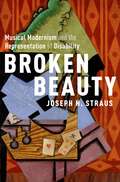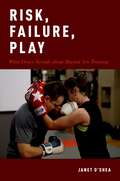- Table View
- List View
The Oxford Handbook of Musical Repatriation (Oxford Handbooks)
by Frank Gunderson, Robert C. Lancefield, Bret WoodsThe Oxford Handbook of Musical Repatriation is a significant edited volume that critically explores issues surrounding musical repatriation, chiefly of recordings from audiovisual archives. The Handbook provides a dynamic and richly layered collection of stories and critical questions for anyone engaged or interested in repatriation or archival work. Repatriation often is overtly guided by an ethical mandate to "return" something to where it belongs, by such means as working to provide reconnection and Indigenous control and access to cultural materials. Essential as these mandates can be, this remarkable volume reveals dimensions to repatriation beyond those which can be understood as simple acts of "giving back" or returning an archive to its "homeland." Musical repatriation can entail subjective negotiations involving living subjects, intangible elements of cultural heritage, and complex histories, situated in intersecting webs of power relations and manifold other contexts. The forty-eight expert authors of this book's thirty-eight chapters engage with multifaceted aspects of musical repatriation, situating it as a concept encompassing widely ranging modes of cultural work that can be both profoundly interdisciplinary and embedded at the core of ethnographic and historical scholarship. These authors explore a rich variety of these processes' many streams, making the volume a compelling space for critical analysis of musical repatriation and its wider significance. The Handbook presents these chapters in a way that offers numerous emergent perspectives, depending on one's chosen trajectory through the volume. From retracing the paths of archived collections to exploring memory, performance, research goals, institutional power, curation, preservation, pedagogy and method, media and transmission, digital rights and access, policy and privilege, intellectual property, ideology, and the evolving institutional norms that have marked the preservation and ownership of musical archives-The Oxford Handbook of Musical Repatriation addresses these key topics and more in a deep, richly detailed, and diverse exploration.
INTEGRATED STRING PLAYER TIM C: Embodied Vibration (The Integrated Musician)
by Pedro de AlcantaraPedro de Alcantara's The Integrated String Player: Embodied Vibration is a practical guide for all string players: violinists and violists, cellists and bassists, but also gamba players and anyone who makes music drawing a bow across a string. Dozens of exercises, supported by a dedicated website with 80 video clips, cover all the basics of string playing, including left-hand articulation, vibrato, changes of position, double-stopping, sound production, string crossings, and many other techniques. Each exercise, however simple or complex, can become a meditation with the goal of integrating the musical, technical, and metaphysical aspects of a player's practice. Part I is devoted to the fundamentals of coordination, rhythm, and listening in depth. Part II focuses on the left hand, with an emphasis on healthy gestures that are charged with musicality and meaning. Part III covers the bowing arm, exploring innovative concepts such as expressive gesticulation, mechanical intelligence, and the use of the bow as the player's voice, both literally and symbolically. Part IV covers the integration of analytical thought and sensorial practice, providing an extensive study of the harmonic series, the circle of fifths, Tartini tones, and many other sonic aspects that are essential to a string player's musical freedom. In addition, the conversational, linguistic, compositional, and improvisatory dimensions of string playing are discussed and supported by multiple practical exercises. The Integrated String Player is addressed to players of all abilities and from all aesthetic backgrounds: students and professionals, teachers and performers, classically trained musicians and jazz players, chamber-music players and orchestral players.
Henry Purcell's Dido and Aeneas
by Ellen T. HarrisPurcell's Dido and Aeneas stands as the greatest operatic achievement of seventeenth-century England, and yet, despite its global renown, it remains cloaked in mystery. The date and place of its first performance cannot be fixed with precision, and the absolute accuracy of the surviving scores, which date from almost 100 years after the work was written, cannot be assumed. In this thirtieth-anniversary new edition of her book, Ellen Harris closely examines the many theories that have been proposed for the opera's origin and chronology, considering the opera both as political allegory and as a positive exemplar for young women. Her study explores the work's historical position in the Restoration theater, revealing its roots in seventeenth-century English theatrical and musical traditions, and carefully evaluates the surviving sources for the various readings they offer-of line designations in the text (who sings what), the vocal ranges of the soloists, the use of dance and chorus, and overall layout. It goes on to provide substantive analysis of Purcell's musical declamation and use of ground bass. In tracing the performance history of Dido and Aeneas, Harris presents an in-depth examination of the adaptations made by the Academy of Ancient Music at the end of the eighteenth century based on the surviving manuscripts. She then follows the growing interest in the creation of an "authentic" version in the nineteenth and early twentieth centuries through published editions and performance reviews, and considers the opera as an important factor in the so-called English Musical Renaissance. To a significant degree, the continuing fascination with Purcell's Dido and Aeneas rests on its apparent mutability, and Harris shows this has been inherent in the opera effectively from its origin.
The Oxford Handbook of Community Music (Oxford Handbooks)
by Brydie-Leigh Bartleet and Lee HigginsCommunity music as a field of practice, pedagogy, and research has come of age. The past decade has witnessed an exponential growth in practices, courses, programs, and research in communities and classrooms, and within the organizations dedicated to the subject. The Oxford Handbook of Community Music gives an authoritative and comprehensive review of what has been achieved in the field to date and what might be expected in the future. This Handbook addresses community music through five focused lenses: contexts, transformations, politics, intersections, and education. It not only captures the vibrant, dynamic, and divergent approaches that now characterize the field, but also charts the new and emerging contexts, practices, pedagogies, and research approaches that will define it in the coming decades. The contributors to this Handbook outline community music's common values that center on social justice, human rights, cultural democracy, participation, and hospitality from a range of different cultural contexts and perspectives. As such, The Oxford Handbook of Community Music provides a snapshot of what has become a truly global phenomenon.
The Notebooks of Alexander Skryabin
by Simon NichollsRussian composer Alexander Skryabin's life spanned the late romantic era and the momentous early years of the twentieth century, but was cut short before the end of the first world war. In a predominantly conservative era in the Russian musical scene, he drew inspiration from poets, philosophers, and dramatists of the Silver Age, a period of radical artistic renewal in Russia. Possessed by an apocalyptic vision of transformation, aspects of which he shared with other Russian thinkers and artists of the period, Skryabin transformed his musical language from a ripe Romantic style into a far-reaching, radical instrument for the expression of his ideas. This newly translated collection of the composer's writings and letters allows readers to experience and understand Skryabin's worldview, personality, and life as never before. The Notebooks of Alexander Skryabin features commentary based on original materials and accounts by the composer's friends and associates, dispelling popular misconceptions about his life and revealing the dazzling constellation of philosophies that comprised his world of ideas, from Ancient Greek and German Idealist philosophy to the writings of Nietzsche, and Indian culture to the Theosophical writings of H. P. Blavatsky. Close textual readings and new biographical insights converge to present a vivid impression of Skryabin's thought and its impact on his musical compositions.
The Notebooks of Alexander Skryabin
by Simon NichollsRussian composer Alexander Skryabin's life spanned the late romantic era and the momentous early years of the twentieth century, but was cut short before the end of the first world war. In a predominantly conservative era in the Russian musical scene, he drew inspiration from poets, philosophers, and dramatists of the Silver Age, a period of radical artistic renewal in Russia. Possessed by an apocalyptic vision of transformation, aspects of which he shared with other Russian thinkers and artists of the period, Skryabin transformed his musical language from a ripe Romantic style into a far-reaching, radical instrument for the expression of his ideas. This newly translated collection of the composer's writings and letters allows readers to experience and understand Skryabin's worldview, personality, and life as never before. The Notebooks of Alexander Skryabin features commentary based on original materials and accounts by the composer's friends and associates, dispelling popular misconceptions about his life and revealing the dazzling constellation of philosophies that comprised his world of ideas, from Ancient Greek and German Idealist philosophy to the writings of Nietzsche, and Indian culture to the Theosophical writings of H. P. Blavatsky. Close textual readings and new biographical insights converge to present a vivid impression of Skryabin's thought and its impact on his musical compositions.
Samuel Barber: The Composer and His Music
by Barbara B. HeymanSamuel Barber (1910-1981) is one of the most admired and honored American composers of the twentieth century. An unabashed Romantic, largely independent of worldwide trends and the avant-garde, he infused his works with poetic lyricism and gave tonal language and forms new vitality. His rich legacy includes every genre, including the famous Adagio for Strings, Knoxville: Summer of 1915, three concertos, a plethora of songs, and two operas, the Pulitzer prize-winning Vanessa, and Antony and Cleopatra, the commissioned work that opened the new Metropolitan Opera House at Lincoln Center in 1966. Generously documented by letter, sketches, autograph manuscripts, and interviews with friends, colleagues, and performers with whom he worked, this ASCAP-Award winning book is still unquestionably the most authoritative biography on Barber, covering his entire career and interweaving the events of his life with his compositional process. This second edition benefits from many new discoveries, including a Violin Sonata recovered from an artist's estate, a diary Barber kept his seventeenth year, a trove of letters and manuscripts that were recovered from a suitcase found in a dumpster, documentation that dispels earlier myths about the composition of Barber's Violin Concerto, and research of scholars that was stimulated by Heyman's work. Barber's intimate relations are discussed when they bear on his creativity. A testament to the lasting significance of Romanticism, Samuel Barber stands as a model biography of an important musical figure.
Samuel Barber: The Composer and His Music
by Barbara B. HeymanSamuel Barber (1910-1981) is one of the most admired and honored American composers of the twentieth century. An unabashed Romantic, largely independent of worldwide trends and the avant-garde, he infused his works with poetic lyricism and gave tonal language and forms new vitality. His rich legacy includes every genre, including the famous Adagio for Strings, Knoxville: Summer of 1915, three concertos, a plethora of songs, and two operas, the Pulitzer prize-winning Vanessa, and Antony and Cleopatra, the commissioned work that opened the new Metropolitan Opera House at Lincoln Center in 1966. Generously documented by letter, sketches, autograph manuscripts, and interviews with friends, colleagues, and performers with whom he worked, this ASCAP-Award winning book is still unquestionably the most authoritative biography on Barber, covering his entire career and interweaving the events of his life with his compositional process. This second edition benefits from many new discoveries, including a Violin Sonata recovered from an artist's estate, a diary Barber kept his seventeenth year, a trove of letters and manuscripts that were recovered from a suitcase found in a dumpster, documentation that dispels earlier myths about the composition of Barber's Violin Concerto, and research of scholars that was stimulated by Heyman's work. Barber's intimate relations are discussed when they bear on his creativity. A testament to the lasting significance of Romanticism, Samuel Barber stands as a model biography of an important musical figure.
Art & Science in the Choral Rehearsal
by Sharon J. PaulIn recent decades, cognitive neuroscience research has increased our understanding of how the brain learns, retains, and recalls information. At the same time, social psychologists have developed insights into group dynamics, exploring what motivates individuals in a group to give their full effort, or conversely, what might instead inspire them to become free loaders. Art and Science in the Choral Rehearsal explores the idea that choral conductors who better understand how the brain learns, and how individuals within groups function, can lead more efficient, productive, and enjoyable rehearsals. Armed with this knowledge, conductors can create rehearsal techniques which take advantage of certain fundamental brain and social psychology principles. Through such approaches, singers will become increasingly engaged physically and mentally in the rehearsal process. Art and Science in the Choral Rehearsal draws from a range of scientific studies to suggest and encourage effective, evidence-based techniques, and can help serve to reset and inspire new approaches toward teaching. Each chapter outlines exercises and creative ideas for conductors and music teachers, including the importance of embedding problem solving into rehearsal, the use of multiple entry points for newly acquired information, techniques to encourage an emotional connection to the music, and ways to incorporate writing exercises into rehearsal. Additional topics include brain-compatible teaching strategies to complement thorough score study, the science behind motivation, the role imagination plays in teaching, the psychology of rehearsal, and conducting tips and advice. All of these brain-friendly strategies serve to encourage singers' active participation in rehearsals, with the goal of motivating beautiful, inspired, and memorable performances.
Art & Science in the Choral Rehearsal
by Sharon J. PaulIn recent decades, cognitive neuroscience research has increased our understanding of how the brain learns, retains, and recalls information. At the same time, social psychologists have developed insights into group dynamics, exploring what motivates individuals in a group to give their full effort, or conversely, what might instead inspire them to become free loaders. Art and Science in the Choral Rehearsal explores the idea that choral conductors who better understand how the brain learns, and how individuals within groups function, can lead more efficient, productive, and enjoyable rehearsals. Armed with this knowledge, conductors can create rehearsal techniques which take advantage of certain fundamental brain and social psychology principles. Through such approaches, singers will become increasingly engaged physically and mentally in the rehearsal process. Art and Science in the Choral Rehearsal draws from a range of scientific studies to suggest and encourage effective, evidence-based techniques, and can help serve to reset and inspire new approaches toward teaching. Each chapter outlines exercises and creative ideas for conductors and music teachers, including the importance of embedding problem solving into rehearsal, the use of multiple entry points for newly acquired information, techniques to encourage an emotional connection to the music, and ways to incorporate writing exercises into rehearsal. Additional topics include brain-compatible teaching strategies to complement thorough score study, the science behind motivation, the role imagination plays in teaching, the psychology of rehearsal, and conducting tips and advice. All of these brain-friendly strategies serve to encourage singers' active participation in rehearsals, with the goal of motivating beautiful, inspired, and memorable performances.
The Mindful Musician: Mental Skills for Peak Performance
by Vanessa CornettIn The Mindful Musician: Mental Skills for Peak Performance, author Vanessa Cornett offers guidelines to help musicians cultivate artistic vision, objectivity, freedom, quiet awareness, and self-compassion, both on- and offstage in order to become more resilient performers. Contrary to modern culture's embrace of busyness and divided attention, Cornett's contemplative techniques provide greater space for artistic self-expression and satisfaction. With the aid of a companion website that includes audio files and downloadable templates, The Mindful Musician provides a method to promote attentional focus, self-assessment, emotional awareness, and creativity. The first of its kind to combine mindfulness practices with research in cognitive and sport psychology, this book helps musicians explore the roots of anxiety and other challenges related to performance, all through the deliberate focus of awareness.
MINDFUL MUSICIAN C: Mental Skills for Peak Performance
by Vanessa CornettIn The Mindful Musician: Mental Skills for Peak Performance, author Vanessa Cornett offers guidelines to help musicians cultivate artistic vision, objectivity, freedom, quiet awareness, and self-compassion, both on- and offstage in order to become more resilient performers. Contrary to modern culture's embrace of busyness and divided attention, Cornett's contemplative techniques provide greater space for artistic self-expression and satisfaction. With the aid of a companion website that includes audio files and downloadable templates, The Mindful Musician provides a method to promote attentional focus, self-assessment, emotional awareness, and creativity. The first of its kind to combine mindfulness practices with research in cognitive and sport psychology, this book helps musicians explore the roots of anxiety and other challenges related to performance, all through the deliberate focus of awareness.
Teacher Evaluation in Music: A Guide for Music Teachers in the U.S.
by Cara Faith Bernard Joseph Michael AbramoTeacher Evaluation in Music: A Guide for Music Teachers in the U. S. aims to help music teachers navigate the controversial terrain of teacher evaluation. Rather than entering the debate on policy divorced from practice, this book is intended as a pragmatic approach to help music teachers to thrive within teacher evaluation systems and as a way to improve practice. Using Shulman's concept of content knowledge, general pedagogical knowledge, and pedagogical content knowledge, this book strives to help music teachers find a balance between advocating for themselves and their programs and for using teacher evaluation to improve their teaching. The book covers history of policy and law of teacher evaluation and the competing uses of teacher evaluation to rate teachers or as a professional development tool. The descriptions of policies, laws, and competing uses are approached in a way to help music teachers use teacher evaluation for their benefit to grow as professionals. This book has chapters devoted to giving detailed and specific strategies in key areas that research has suggested music teachers struggle to implement: questioning, literacy, differentiated instruction, and assessment. Complimenting these key areas are sample lesson plans which apply the strategies of questioning, differentiation, literacy, and assessment discussed in each chapter. These lessons serve as a resource and guide for teachers to develop their own lessons and improve their practice. The final chapter gives guidance on how music teachers may talk to administrators and evaluators to make teacher evaluation productive. Through these detailed descriptions of understanding teacher evaluation, talking to evaluators, and improving practice, music teachers may not just survive but thrive in these systems of accountability.
TEACHER EVALUATION IN MUSIC C: A Guide for Music Teachers in the U.S.
by Cara Faith Bernard Joseph Michael AbramoTeacher Evaluation in Music: A Guide for Music Teachers in the U. S. aims to help music teachers navigate the controversial terrain of teacher evaluation. Rather than entering the debate on policy divorced from practice, this book is intended as a pragmatic approach to help music teachers to thrive within teacher evaluation systems and as a way to improve practice. Using Shulman's concept of content knowledge, general pedagogical knowledge, and pedagogical content knowledge, this book strives to help music teachers find a balance between advocating for themselves and their programs and for using teacher evaluation to improve their teaching. The book covers history of policy and law of teacher evaluation and the competing uses of teacher evaluation to rate teachers or as a professional development tool. The descriptions of policies, laws, and competing uses are approached in a way to help music teachers use teacher evaluation for their benefit to grow as professionals. This book has chapters devoted to giving detailed and specific strategies in key areas that research has suggested music teachers struggle to implement: questioning, literacy, differentiated instruction, and assessment. Complimenting these key areas are sample lesson plans which apply the strategies of questioning, differentiation, literacy, and assessment discussed in each chapter. These lessons serve as a resource and guide for teachers to develop their own lessons and improve their practice. The final chapter gives guidance on how music teachers may talk to administrators and evaluators to make teacher evaluation productive. Through these detailed descriptions of understanding teacher evaluation, talking to evaluators, and improving practice, music teachers may not just survive but thrive in these systems of accountability.
Electronic Inspirations: Technologies of the Cold War Musical Avant-Garde (The New Cultural History of Music Series)
by Jennifer IversonFor a decimated post-war West Germany, the electronic music studio at the WDR radio in Cologne was a beacon of hope. Jennifer Iverson's Electronic Inspirations: Technologies of the Cold War Musical Avant-Garde traces the reclamation and repurposing of wartime machines, spaces, and discourses into the new sounds of the mid-century studio. In the 1950s, when technologies were plentiful and the need for reconstruction was great, West Germany began to rebuild its cultural prestige via aesthetic and technical advances. The studio's composers, collaborating with scientists and technicians, coaxed music from sine-tone oscillators, noise generators, band-pass filters, and magnetic tape. Together, they applied core tenets from information theory and phonetics, reclaiming military communication technologies as well as fascist propaganda broadcasting spaces. The electronic studio nurtured a revolutionary synthesis of science, technology, politics, and aesthetics. Its esoteric sounds transformed mid-century music and continue to reverberate today. Electronic music--echoing both cultural anxiety and promise--is a quintessential Cold War innovation.
ELECTRONIC INSPIRATIONS NCHM C: Technologies of the Cold War Musical Avant-Garde (The New Cultural History of Music Series)
by Jennifer IversonFor a decimated post-war West Germany, the electronic music studio at the WDR radio in Cologne was a beacon of hope. Jennifer Iverson's Electronic Inspirations: Technologies of the Cold War Musical Avant-Garde traces the reclamation and repurposing of wartime machines, spaces, and discourses into the new sounds of the mid-century studio. In the 1950s, when technologies were plentiful and the need for reconstruction was great, West Germany began to rebuild its cultural prestige via aesthetic and technical advances. The studio's composers, collaborating with scientists and technicians, coaxed music from sine-tone oscillators, noise generators, band-pass filters, and magnetic tape. Together, they applied core tenets from information theory and phonetics, reclaiming military communication technologies as well as fascist propaganda broadcasting spaces. The electronic studio nurtured a revolutionary synthesis of science, technology, politics, and aesthetics. Its esoteric sounds transformed mid-century music and continue to reverberate today. Electronic music--echoing both cultural anxiety and promise--is a quintessential Cold War innovation.
Teaching the Whole Musician: A Guide to Wellness in the Applied Studio
by Paola SavvidouIn Teaching the Whole Musician: A Guide to Wellness in the Applied Studio, author Paola Savvidou empowers applied music instructors to honor and support their students' wellness through compassion-filled conversation tools, hands-on activities for injury prevention, mental health protection, and recovery support. Many music students are facing devastating injuries and emotional peril as they navigate the transition from student to professional. Experts are sounding the alarm for the need to educate students on the negative effects of habits such as postural misalignments, sleep deprivation, and over exertion. In this book, music teachers will learn how to help students develop skills and learn behaviors that will expand their self-awareness as they work towards a fulfilled career in the arts. With a wealth of additional movement experiences, audio files, and downloadable worksheets, the instructor can easily share movement exercises, nutrition diaries, and meditations with their students. The first guidebook of its kind to address wellness for music students in a comprehensive manner geared towards the applied instructor, this volume provides simple yet impactful techniques for approaching all things wellness.
Teaching the Whole Musician: A Guide to Wellness in the Applied Studio
by Paola SavvidouIn Teaching the Whole Musician: A Guide to Wellness in the Applied Studio, author Paola Savvidou empowers applied music instructors to honor and support their students' wellness through compassion-filled conversation tools, hands-on activities for injury prevention, mental health protection, and recovery support. Many music students are facing devastating injuries and emotional peril as they navigate the transition from student to professional. Experts are sounding the alarm for the need to educate students on the negative effects of habits such as postural misalignments, sleep deprivation, and over exertion. In this book, music teachers will learn how to help students develop skills and learn behaviors that will expand their self-awareness as they work towards a fulfilled career in the arts. With a wealth of additional movement experiences, audio files, and downloadable worksheets, the instructor can easily share movement exercises, nutrition diaries, and meditations with their students. The first guidebook of its kind to address wellness for music students in a comprehensive manner geared towards the applied instructor, this volume provides simple yet impactful techniques for approaching all things wellness.
Sound Relations: Native Ways of Doing Music History in Alaska (American Musicspheres)
by Jessica Bissett PereaSound Relations delves into histories of Inuit musical life in Alaska to register the significance of sound as integral to self-determination and sovereignty. Offering radical and relational ways of listening to Inuit performances across a range of genres--from hip hop to Christian hymnody and traditional drumsongs to funk and R&B --author Jessica Bissett Perea registers how a density (not difference) of Indigenous ways of musicking from a vast archive of presence sounds out entanglements between structures of Indigeneity and colonialism. This work dismantles stereotypical understandings of "Eskimos," "Indians," and "Natives" by addressing the following questions: What exactly is "Native" about Native music? What does it mean to sound (or not sound) Native? Who decides? And how can in-depth analyses of Native music that center Indigeneity reframe larger debates of race, power, and representation in twenty-first century American music historiography? Instead of proposing singular truths or facts, this book invites readers to consider the existence of multiple simultaneous truths, a density of truths, all of which are culturally constructed, performed, and in some cases politicized and policed. Native ways of doing music history engage processes of sound worlding that envision otherwise, beyond nation-state notions of containment and glorifications of Alaska as solely an extraction site for U.S. settler capitalism, and instead amplifies possibilities for more just and equitable futures.
Sound Relations: Native Ways of Doing Music History in Alaska (American Musicspheres)
by Jessica Bissett PereaSound Relations delves into histories of Inuit musical life in Alaska to register the significance of sound as integral to self-determination and sovereignty. Offering radical and relational ways of listening to Inuit performances across a range of genres--from hip hop to Christian hymnody and traditional drumsongs to funk and R&B --author Jessica Bissett Perea registers how a density (not difference) of Indigenous ways of musicking from a vast archive of presence sounds out entanglements between structures of Indigeneity and colonialism. This work dismantles stereotypical understandings of "Eskimos," "Indians," and "Natives" by addressing the following questions: What exactly is "Native" about Native music? What does it mean to sound (or not sound) Native? Who decides? And how can in-depth analyses of Native music that center Indigeneity reframe larger debates of race, power, and representation in twenty-first century American music historiography? Instead of proposing singular truths or facts, this book invites readers to consider the existence of multiple simultaneous truths, a density of truths, all of which are culturally constructed, performed, and in some cases politicized and policed. Native ways of doing music history engage processes of sound worlding that envision otherwise, beyond nation-state notions of containment and glorifications of Alaska as solely an extraction site for U.S. settler capitalism, and instead amplifies possibilities for more just and equitable futures.
DESIGN & ANALY QUANTIT RES MUSIC EDU C
by Peter Miksza Kenneth ElpusIn recent years, academics and professionals in the social sciences have forged significant advances in quantitative research methodologies specific to their respective disciplines. Although new and sophisticated techniques for large-scale data analyses have become commonplace in general educational, psychological, sociological, and econometric fields, many researchers in music education have yet to be exposed to such techniques. Design and Analysis of Quantitative Research in Music Education is a comprehensive reference for those involved with research in music education and related fields, providing a foundational understanding of quantitative inquiry methods. Authors Peter Miksza and Kenneth Elpus update and expand the set of resources that music researchers have at their disposal for conceptualizing and analyzing data pertaining to music-related phenomena. This text is designed to familiarize readers with foundational issues of quantitative inquiry as a point of view, introduce and elaborate upon issues of fundamental quantitative research design and analysis, and expose researchers to new, innovative, and exciting methods for dealing with complex research questions and analyzing large samples of data in a rigorous and thorough manner. With this resource, researchers will be better equipped for dealing with the challenges of the increasingly information-rich and data-driven environment surrounding music education. An accompanying companion website provides valuable supplementary exercises and videos.
Broken Beauty: Musical Modernism and the Representation of Disability
by Joseph N. StrausPreeminent music theorist and leader in the study of music and disability Joseph Straus presents a truly groundbreaking take on musical modernism--demonstrating in an expansive and vivid multimedia presentation that modernist music is inextricably entwined with attitudes toward disability. In Broken Beauty, Straus argues that the most characteristic features of musical modernism--fractured forms, immobilized harmonies, conflicting textural layers, radical simplification of means in some cases, and radical complexity and hermeticism in others--can be understood as musical depictions of disability conditions, including deformity/disfigurement, mobility impairment, madness, idiocy, and autism. Against the traditional medical model of disability, which sees it as a bodily defect requiring diagnosis and normalization or cure, this new sociocultural model of disability sees it as cultural artifact, something that is created by and creates culture. Straus places this revised model of disability against a wide range of canonical, high-art concert music from the first decades of the century through the 1950s. Broken Beauty illustrates how disability is right at the core of musical modernism; it is one of the things that musical modernism is fundamentally about.
Broken Beauty: Musical Modernism and the Representation of Disability
by Joseph N. StrausPreeminent music theorist and leader in the study of music and disability Joseph Straus presents a truly groundbreaking take on musical modernism--demonstrating in an expansive and vivid multimedia presentation that modernist music is inextricably entwined with attitudes toward disability. In Broken Beauty, Straus argues that the most characteristic features of musical modernism--fractured forms, immobilized harmonies, conflicting textural layers, radical simplification of means in some cases, and radical complexity and hermeticism in others--can be understood as musical depictions of disability conditions, including deformity/disfigurement, mobility impairment, madness, idiocy, and autism. Against the traditional medical model of disability, which sees it as a bodily defect requiring diagnosis and normalization or cure, this new sociocultural model of disability sees it as cultural artifact, something that is created by and creates culture. Straus places this revised model of disability against a wide range of canonical, high-art concert music from the first decades of the century through the 1950s. Broken Beauty illustrates how disability is right at the core of musical modernism; it is one of the things that musical modernism is fundamentally about.
Risk, Failure, Play: What Dance Reveals about Martial Arts Training
by Janet O'SheaRisk, Failure, Play illuminates the many ways in which competitive martial arts differentiate themselves from violence. Presented from the perspective of a dancer and writer, this book takes readers through the politics of everyday life as experienced through training in a range of martial arts practices such as jeet kune do, Brazilian jiu jitsu, kickboxing, Filipino martial arts, and empowerment self-defense. Author Janet OâShea shows how play gives us the ability to manage difficult realities with intelligence and demonstrates that physical play, with its immediacy and heightened risk, is particularly effective at accomplishing this task. Risk, Failure, Play also demonstrates the many ways in which physical recreation allows us to manage the complexities of our current social reality. Risk, Failure, Play intertwines personal experience with phenomenology, social psychology, dance studies, performance studies, as well as theories of play and competition in order to produce insights on pleasure, mastery, vulnerability, pain, agency, individual identity, and society. Ultimately, this book suggests that play allows us to rehearse other ways to live than the ones we see before us and challenges us to reimagine our social reality.
RISK, FAILURE, PLAY C: What Dance Reveals about Martial Arts Training
by Janet O'SheaRisk, Failure, Play illuminates the many ways in which competitive martial arts differentiate themselves from violence. Presented from the perspective of a dancer and writer, this book takes readers through the politics of everyday life as experienced through training in a range of martial arts practices such as jeet kune do, Brazilian jiu jitsu, kickboxing, Filipino martial arts, and empowerment self-defense. Author Janet OâShea shows how play gives us the ability to manage difficult realities with intelligence and demonstrates that physical play, with its immediacy and heightened risk, is particularly effective at accomplishing this task. Risk, Failure, Play also demonstrates the many ways in which physical recreation allows us to manage the complexities of our current social reality. Risk, Failure, Play intertwines personal experience with phenomenology, social psychology, dance studies, performance studies, as well as theories of play and competition in order to produce insights on pleasure, mastery, vulnerability, pain, agency, individual identity, and society. Ultimately, this book suggests that play allows us to rehearse other ways to live than the ones we see before us and challenges us to reimagine our social reality.
